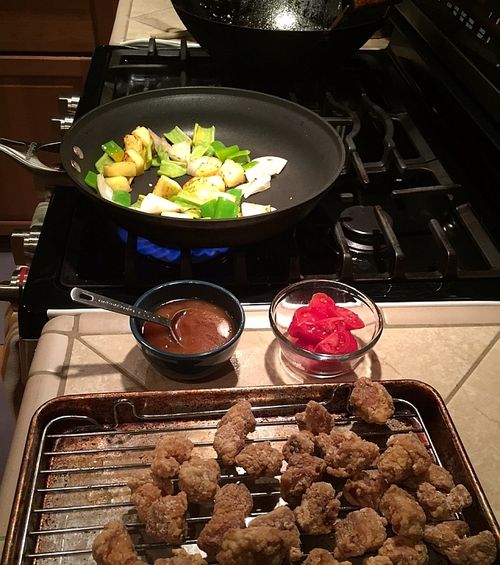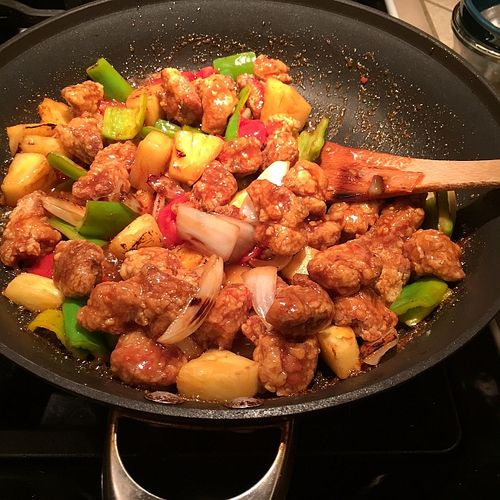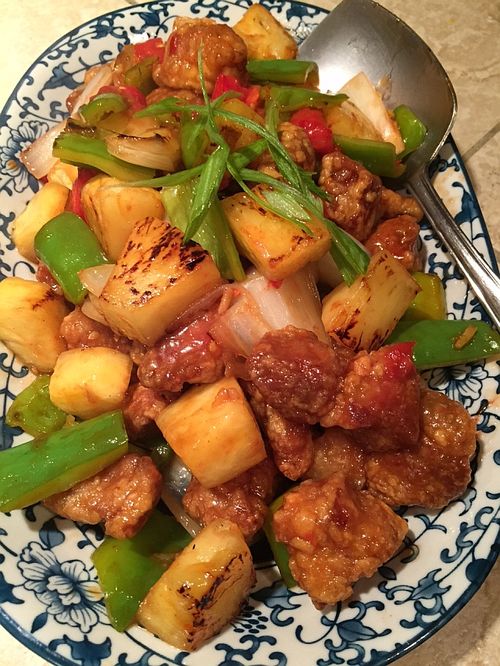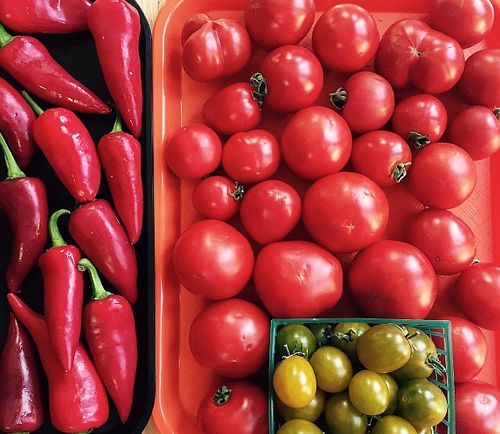“It may be blazing hot but that shouldn’t stop you from deep-frying,” is what I said to myself a few days ago when I decided to make one of my favorite Cantonese dishes. Yes, it was hot in Santa Cruz – in the high 80s inside our house. We wanted to go out to eat but our local Asian options are limited and frankly, not very good. On the other hand, we have amazing ingredients, thanks to Santa Cruz County’s agricultural wealth.
Our farmer’s markets are flushed with ripe peppers these days. I’m not talking regular bell peppers, but Hatch, Jimmy Nardello, Fresno, Jalapenos, Serranos, Thai, Pasilla, Shishito, Padron, and rarities such as Espelette. Tomatoes – from crazy looking heirlooms to candy-like dry-farmed fruits, are being sold by many local farms.
Needless to say, I came home with a variety of peppers and a bunch of tomatoes. Hatch chiles are usually grilled but I also use them in place of bell peppers in stir-fries. (In general, I have a burp aversion to lots of bell peppers in my food.) The dry-farmed tomatoes (below with Fresno chiles) are so sweet right now that I decided to brave the heat and combine the peak produce to make sweet and sour pork.
Why prepare something that I could easily order at a Chinese restaurant? Because restaurants rarely do justice by this incredible Cantonese dish. If I’m going to eat deep-fried food, I’d like the calories to be spent on deliciousness, not gloppy orange cloying sauces, lots of bell pepper pieces and a few overly battered tiny nuggets of pork. If you have a spot for incredible sweet-and-sour pork, stick with it. I do not and I make it myself. Heat wave be damned.
The recipe I used is a favorite old school rendition, with ginger, rice wine, and a touch of soy sauce. It’s by Chris Tan, from his Chinese Heritage Cooking cookbook. Yes, Chris is the same Chris from the purple rice and coconut cupcakes. The pork gets marinated and coated in starch. What’s key is letting the starch set so you get a crisp but light texture, which enables the pork to retain its character while being cloaked in tangy sauce. Fresh pineapple helps too, as does letting it char in the skillet.


I use a wok to fry the pork, then switch to a skillet to stir-fry because as a home cook, I don’t want to be straining and the hot oil to reuse the wok. That seems like an accident in the making as I’m trying to get dinner on the table. The other thing is to line up the stir-fry components to easily move from one ingredient and process to the next, ending with the plating. You’ll see in the photo below what my kitchen counter looked like.
Making sweet-and-sour pork in a heat wave was easier than I thought. To balance out the indulgent stir-fry, Rory made a pot of brown jasmine rice. Together we also made a quick raw kale and cucumber salad similar to this one but we omitted the seaweed. Yin and yang eating at our house.
Celebrate the seasonal bounty with Asian flair.
Recipe
Sweet and Sour Pork
Recipe
Sweet and Sour Pork
Yields 2 to 3 servings with rice and a vegetable dish
Ingredients
Sauce
- About ⅛ teaspoon salt
- 1 teaspoon cornstarch
- 1 tablespoon sugar
- 2 ½ teaspoons Shaoxing rice wine or dry sherry
- 2 ½ teaspoons unseasoned rice vinegar
- Brimming 1 tablespoon soy sauce, regular or gluten-free
- 2 ½ tablespoons plum sauce
- ⅓ cup (60 ml) water
- 10 ounces (300 g) boneless pork shoulder
- 2 ½ teaspoons Shaoxing rice wine or dry sherry
- 1 ¼ teaspoons plus about ⅓ cup (90 ml) cornstarch
- Generous ½ teaspoon oyster sauce
- ½ teaspoon soy sauce, regular or gluten-free
- 2 tablespoon beaten egg
- Canola oil for deep-frying
- ½ small yellow onion, cut into wedges
- 4 ounces (120 g) pineapple cubes, fresh or thawed
- 1 ½ teaspoons minced ginger
- 4 ounces (120 g) mild red and/or green pepper, cut into thumbnail-size squares
- 1 small ripe tomato, peeld with a vegetable peeler and cut into 6 to 8 wedges
- 1 green onion, cut on the steep diagonal into “horse ear” shapes
Instructions
- For the sauce, combine the salt, cornstarch, sugar, rice wine, vinegar, soy sauce, plum sauce and water in a measuring cup. Taste and adjust the flavors for pleasant tart-sweet-salty flavor. Set aside.
- Trim and cut the pork into pieces the size of a cherry or small ice cube. Put into a bowl and add the rice wine, 1 ¼ teaspoons cornstarch, oyster sauce, and soy sauce. Set aside to marinate for 30 minutes. Meanwhile, prep the remaining ingredients, if you haven’t, and get a pot of rice going.
- Heat about ¾-inch (2 cm) of oil in a wok, deep skillet or low saucepan to about 350F (175 to 180C). As that happens, add the egg to the pork to coat well. Put the cornstarch on a plate and dredge the pork. Let sit to get absorbed and set, about 3 or 4 minutes.
- In batches, fry the pork for 2 to 3 minutes, until pale golden. Let drain on paper towel and/or a rack. To crisp the pork, raise the heat on the oil until very hot (about 375F / 190C). Slide all the fried pork cubes back into the oil and refry until a rich brown and crisp. Re-drain. (It’s a pain in the butt to pour the oil out and clean what you just fried in, so use a clean skillet or wok for the next step.)
- Heat a large skillet or wok over high heat. Swirl in 2 teaspoons oil, then add the onion and pineapple. Fry for about 2 minutes, stirring and flipping, until the pineapple picks up some dark brown streaks. Add the ginger and pepper. Cook, stirring constantly, for 1 minute, until the peppers are crisp tender.
- Add the tomato and pour in the sauce. Cook, stirring, for 30 to 45 seconds, until the sauce bubbles and thickens. Add the pork and stir to combine and coat. Transfer to a serving plate, garnish with the green onion and enjoy with lots of rice.
Adapted from: Christopher Tan and Amy Van’s Chinese Heritage Cooking
Related [helpful] posts:
- Deep-frying tips (to help you get over your fear of frying)
- How to cook perfect rice
- Brown Jasmine Rice
- Kale, Cucumber and Seaweed Salad
- Gluten-free Soy Sauce and Tamari Tasting


















